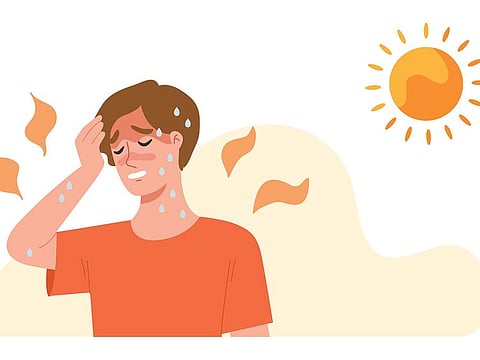What happens to your body during a heat stroke? UAE doctor answers
Difference between exertion, classic heat strokes, treatment and prevention explained

Abu Dhabi: As summer peaks, a UAE-based doctor has cautioned residents about staying protected against heat strokes.
Some groups become more vulnerable, such as the elderly and people who are obese, because too much heat hinders the body’s ability to regulate its temperature, said Dr. Imad Al Majzoub, Consultant Emergency Medicine at Sheikh Shakhbout Medical City (SSMC), Abu Dhabi.
“Heat stroke is defined as a dysfunction in the Central Nervous System (CNS) which is accompanied by a systemic inflammatory response at a temperature of 40°C or greater. It is considered to be a medical emergency.”
Signs of CNS dysfunction include irritability and confusion but may progress to seizures, altered mental status and coma, he warned.
Circulatory collapse/shock can also be present in a number of heat stroke patients with bleeding occuring inmultiple body sites, he added.
According to Dr Majzoub, “Heat stroke is divided into two categories: Exertional heat stroke and classic heat stroke.

“Classic heat stroke on the other hand involves patients who have poor physiologic mechanisms for heat regulation. They include groups with comorbidities, the elderly, young children, those on medications that impair physiologic responses to heat, or those with psychiatric or socioeconomic barriers,” he said.
Effective treatment
Dr. Al Majzoub said, “Early recognition is key to effective treatment of a heat stroke. The person must first move away from the hot environment; stop all voluntary physical activity. Rapid cooling is the most common therapy used in treating classic and exertional heat stroke. The cooling should be initiated as soon as possible, even in the pre-hospital setting. The patient’s clothing should be removed prior to cooling. Most evidence supports immersion and evaporative cooling mechanisms.”
He said cold water immersion is the most effective modality for rapid cooling in patients, especially in cases of exertional heat stroke. This method involves placing the patient in a bath of cold or ice water. Immersion can be impractical in the hospital setting and makes accessing the patient for monitoring and interventions difficult, he added.
The doctor said, “Evaporative cooling involves spraying the patient’s skin with tepid water and then fanning the patient. This method has been studied more in classic heat stroke and is thought to be more effective in elderly patients in particular and in heat exhaustion cases in general.”
He said conductive cooling can be achieved using cooling blankets. Ice packs are most effective when applied to the whole body. There is limited benefit of ice packs placed only on the axillae, neck and groin though, he cautioned.
Whole-body cooling by this manner can best be achieved by actively shifting ice packs and ice water soaked towels across the body.
Cold intravenous fluids may also supplement other methods of cooling but are not considered sufficient on their own.
There is no evidence for the use of any pharmacologic agent, the doctor said.
Prevention is the key
Dr. Al Majzoub said, “Prevention is key for all heat-related illnesses. Avoiding exertion or being outdoors at peaking daily temperature and maintaining hydration are mainstays in prevention. The wet-bulb globe temperature index should be used for the assessment of environmental heat risk. If not available, the heat index can be used.”
He said athletes and those working outdoors in training are vulnerable to heat illness, regardless of how high the temperature soars. Trainers, supervisors and medical staff should be educated on early recognition of heat strokes.
Acclimatisation to hot and humid environments is also ised a technique by doing one-two hours of exercise outdoors over 10-14 days.
Overweight or obese individuals may be at increased risk for heat-related illness, so they must take special care.
A former case of heat stroke can put an individual at risk for subsequent heat-related illness for months following the event.
The most reliably modifiable risk factor is the hydration status, he noted.
“Dehydration has been linked to increased physiological strain, decreased sweat rates, increased perceived exertion and increased core temperatures. Hyperhydration has not been shown to have an effect on heat tolerance. Guidelines suggest that hydration before activity and a ‘drink to thirst’ mentality during exertion are preventative for heat-related illness,” he added.
Sign up for the Daily Briefing
Get the latest news and updates straight to your inbox



